MARIANI’SVirtual
Gourmet
March 31,
2013
NEWSLETTER

HAPPY EASTER
THIS WEEK
WHAT'S NEW IN VEGAS?
by John A. Curtas
NEW YORK CORNER
Sirio
by John Mariani
Notes from the
Wine Cellar
Saint Julien
by Brian Freedman
❖❖❖
WHAT'S
NEW IN VEGAS?
by John A. Curtas
The Star Chefs Are Still Coming but Off the
Strip Are the Locals' Secrets
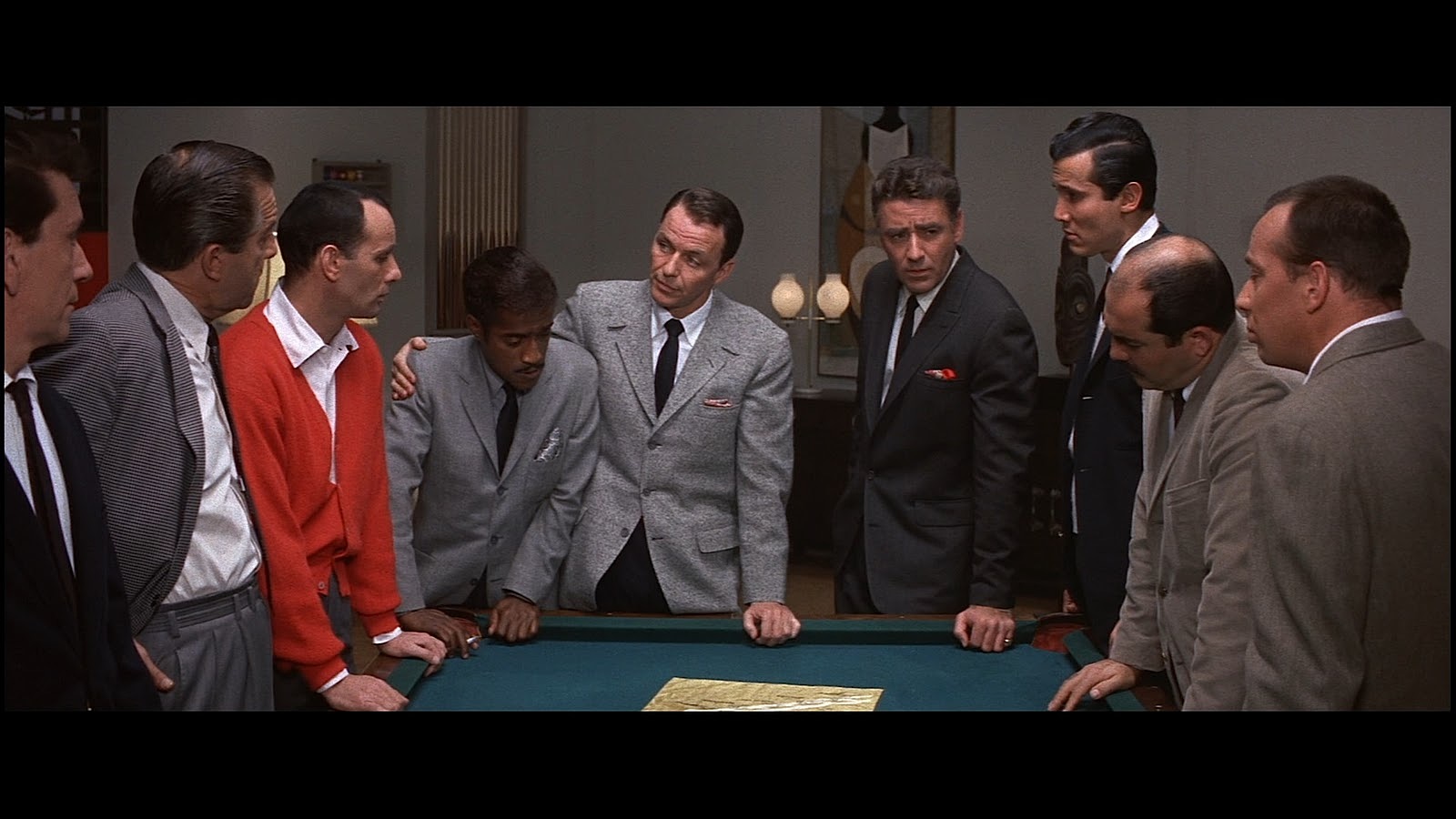
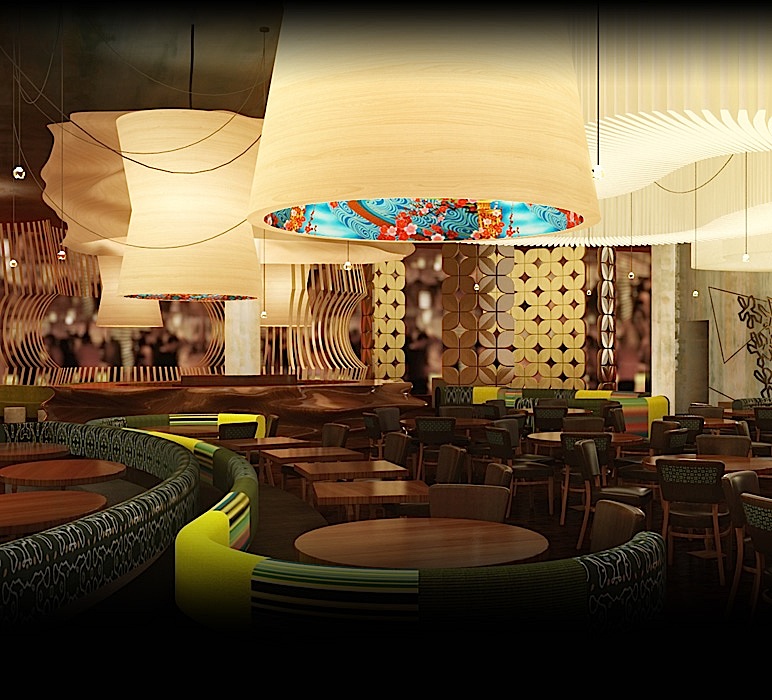 NOBU
NOBU
In
Caesars Palace Hotel and Casino
3570
Las Vegas Boulevard South
888-509-0520
Nobu Matsuhisa’s new Nobu
in Caesars Palace is the perfect example of
what happens when a celebrity chef sells out and
uses Las Vegas to cash in.
It is the gastronomic equivalent
of a once-innovative cook deciding to abandon his
legacy to the highest bidder and spend his
retirement padding around his culinary house in a
succulent silk robe and savory slippers.
You will
eat well here, if you keep things simple, but you
will also feel like you were backed over by a
Brink’s truck when you get your bill.
This Nobu is 325 seats small, with a menu longer
than my last divorce decree. The 166-item (yes, I
counted), 4-page menu is all over the map, running
the gamut from a tiny cylinder of
underseasoned yellowtail mush topped with good
caviar ($28) to "Inaniwa Pasta with Lobster" that
will set you back a cool $34 for four chunks of
lobster atop thin udon noodles. Almost last and
definitely least are the "Nobu Style Taco(s),"
priced at ten bucks per for teeny tiny tacos
containing just enough fish to satisfy the tariff.
None of this would matter if they tasted like
anything other than the flaky shell that surrounds
them, but they don't and you will feel hosed. There
are usually no less than ten sushi chefs on duty, a
half dozen hostesses, and so many waiters they need
a traffic cop at the delivery stations to keep
collisions from happening. Of course, this is
nothing new for a celeb chef opening in Vegas. In
their first month of operation, casino restaurants
typically load up with roughly double the staff they
will need once the shakedown cruise is over.
The amazing thing is that some of the food, like the
sushi, is a lot better than it has to be. It is top
drawer, expertly cut and served on beautiful, barely
warm and barely held-together perfumed rice. There's
no slack in the sashimi, either. Whether this
level of 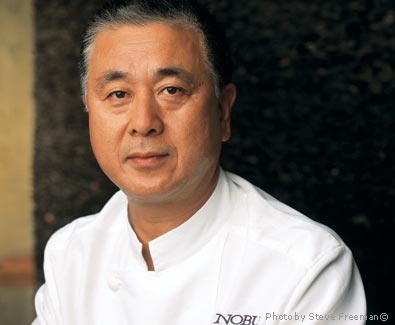 quality
holds true once the opening hubbub dies down (and
once there aren't ten sushi chefs manning the
counter) remains to be seen. But in the meantime,
you will eat some of the most pristine fish you will
ever find 250 miles from the nearest ocean.
quality
holds true once the opening hubbub dies down (and
once there aren't ten sushi chefs manning the
counter) remains to be seen. But in the meantime,
you will eat some of the most pristine fish you will
ever find 250 miles from the nearest ocean.
Tempura fans may swoon over the crispy, barely-there
batter that envelops the "King Crab with Amazu
Ponzu," and it’s hard to fault. If you seek a flavor
depth charge, the mixed toban-yaki
(ceramic-grilled) seafood ($32) fills the bill with
grilled fish and lots of big vegetables sharing a
bowl with a sauce so good you will ask for a spoon.
Once you get past those, your tariff and
disappointment will mount quickly. Order the spicy
scallop hand cut roll ($12) and you will get a
panatella-sized roll of rice containing an
itty-bitty piece of scallop and zero spice. The same
holds true for the Big Eye tuna with asparagus roll
($12), both indistinguishable from something you'd
pick up at a supermarket. What you might call
yakitori, this menu calls kushiyaki.
Either way, it's simply grilling
something-on-a-stick, and either way, there isn't
enough protein offered on the chewy-but-tasty squid
($13) or the dice-sized pork belly ($14) to satisfy
even the most modest appetites.
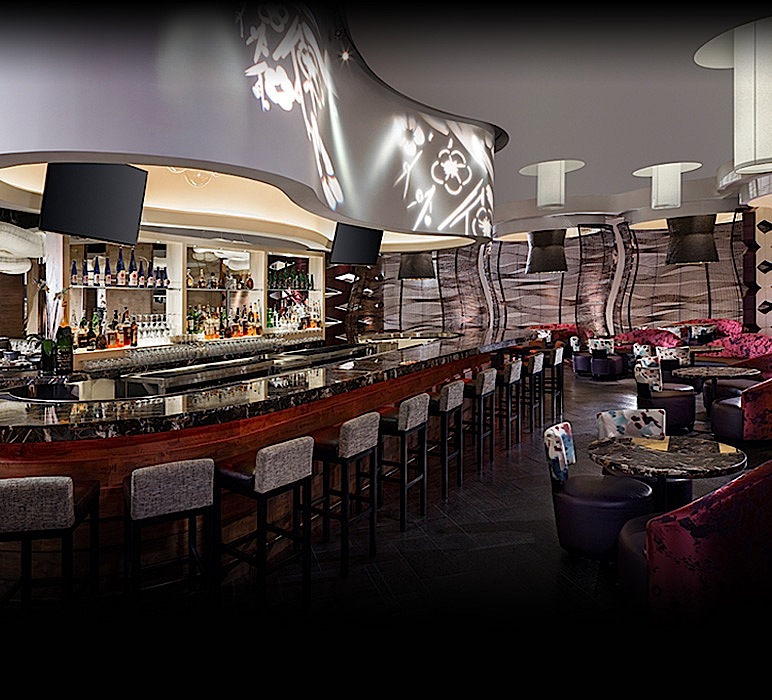 Portion
sizes at least venture into big boy land with the
brick oven dishes, even if menu descriptions leave
you scratching your head. Tearing into the roasted poussin
(baby chicken, $38), you will be impressed with the
tastiness of the bird and the perfection of the
roasting, but might find yourself searching for a
hint of the "spicy lemon" promised by the menu.
Equally misleading is the "Umami Seabass" ($42) -- a
gorgeous chunk of lip-smacking fish that, once
again, promised much more than it delivered. (Note
to Nobu: If you're going to stick the "umami"
label on anything, you'd better deliver the goods.)
Portion
sizes at least venture into big boy land with the
brick oven dishes, even if menu descriptions leave
you scratching your head. Tearing into the roasted poussin
(baby chicken, $38), you will be impressed with the
tastiness of the bird and the perfection of the
roasting, but might find yourself searching for a
hint of the "spicy lemon" promised by the menu.
Equally misleading is the "Umami Seabass" ($42) -- a
gorgeous chunk of lip-smacking fish that, once
again, promised much more than it delivered. (Note
to Nobu: If you're going to stick the "umami"
label on anything, you'd better deliver the goods.)
Finally, there is the sake list -- nine of them, all from
the same producer in the Niigata prefecture. Only
one of the nine offerings is priced at $75 for a 500
ml bottle, and things get stratospheric very quickly
after that. Suffice it to say that reducing your
list to a few offerings from a single, expensive
producer is the equivalent of Joël
Robuchon stating he will only serve
classified growth Bordeaux with his food. But I
guess when the time comes to cash in, you can do
these things with a clear conscience.
Nobu
is open for dinner only seven days a week, from
5pm-11pm. Prices start at $5-$12 per piece for
sushi/sashimi and average $40+ for entrees.
HONEY SALT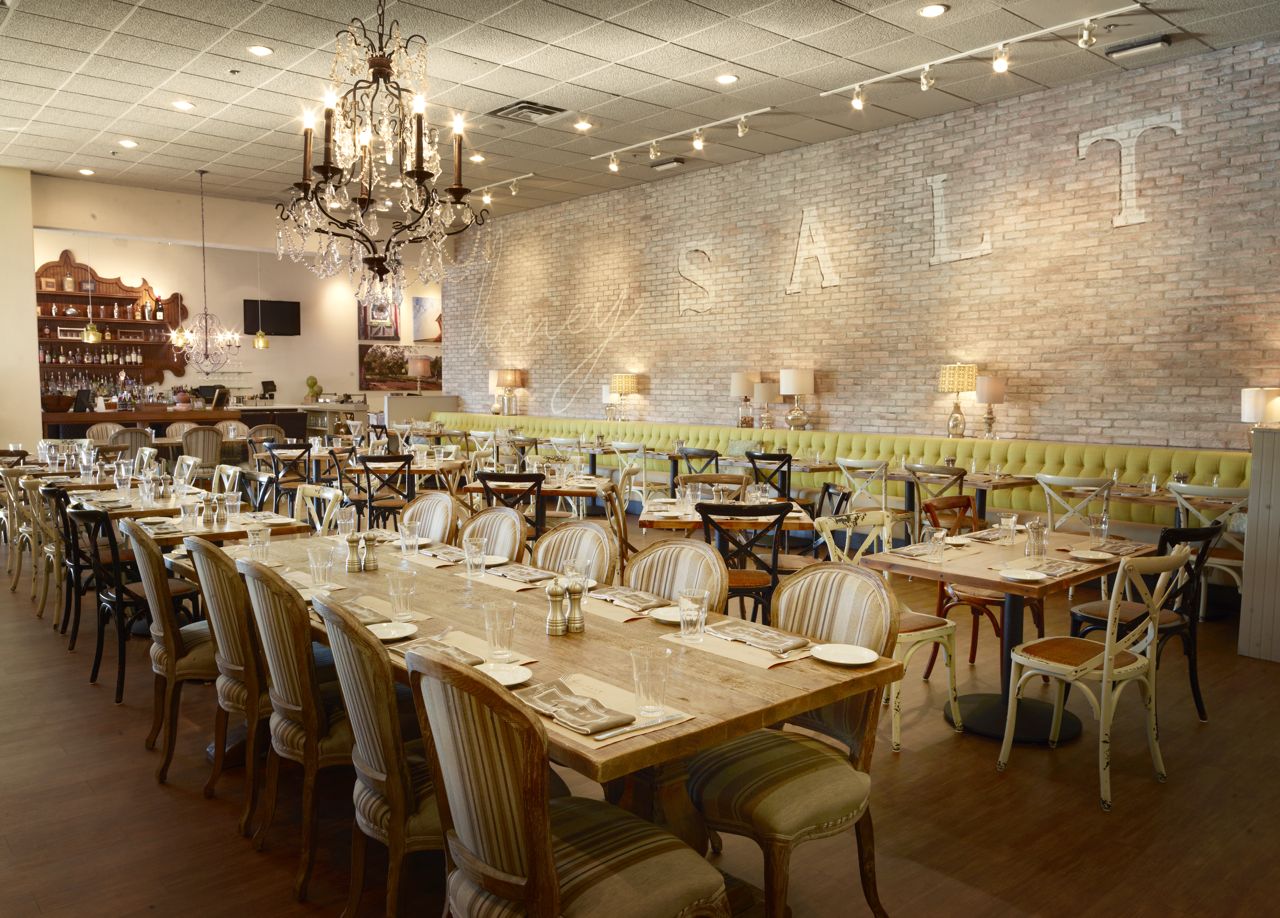
1031
South Rampart Blvd.
702-445-6100
For all the noise that Nobu is
making on the Strip, it is in the neighborhoods
where most local palates are turning these days.
After decades of starving for anything other than
franchises and mediocrity, Summerlin (Las Vegas’
most affluent neighborhood) has had two new arrivals
within a few months and a half mile of each other.
both have been packed since opening day.
Honey Salt is the brainchild of über-restaurant
consultant Elizabeth Blau (below) and chef-husband Kim
Canteenwalla, with exec chef Joseph Zanelli (below).
Everything from its shabby-chic décor to its
farm-to-table menu is designed to appeal to the
downward mobility of most diners in this second
decade of the 21st
Century.
Honey Salt's menu does try
too hard to be something for everyone (scallops, salmon, chicken and beef, etc.), but
if you know where to look, there are gems to be
found. A shot of "Green Goddess Juice" may be
expensive at seven bucks, but seems to possess
mystical, health-giving properties. You'll swear you
feel better after the first swig. The New England
Fry -- basically clams and calamari -- suffers from
not enough lemon in the aïoli, but otherwise
it’s a crispy evocation of everything fried seafood
can be. But the real winners on the apps list are
the turkey meatballs topped with fresh, grated
horseradish, and the aggressively-spiced Tuscan
cannellini bean soup -- both as deeply flavored and
well-constructed as any starters in town.
salmon, chicken and beef, etc.), but
if you know where to look, there are gems to be
found. A shot of "Green Goddess Juice" may be
expensive at seven bucks, but seems to possess
mystical, health-giving properties. You'll swear you
feel better after the first swig. The New England
Fry -- basically clams and calamari -- suffers from
not enough lemon in the aïoli, but otherwise
it’s a crispy evocation of everything fried seafood
can be. But the real winners on the apps list are
the turkey meatballs topped with fresh, grated
horseradish, and the aggressively-spiced Tuscan
cannellini bean soup -- both as deeply flavored and
well-constructed as any starters in town.
Things get dicier when you venture to the main parts
of the menu. My burger has been overcooked and
under-seasoned both times I've tried it, 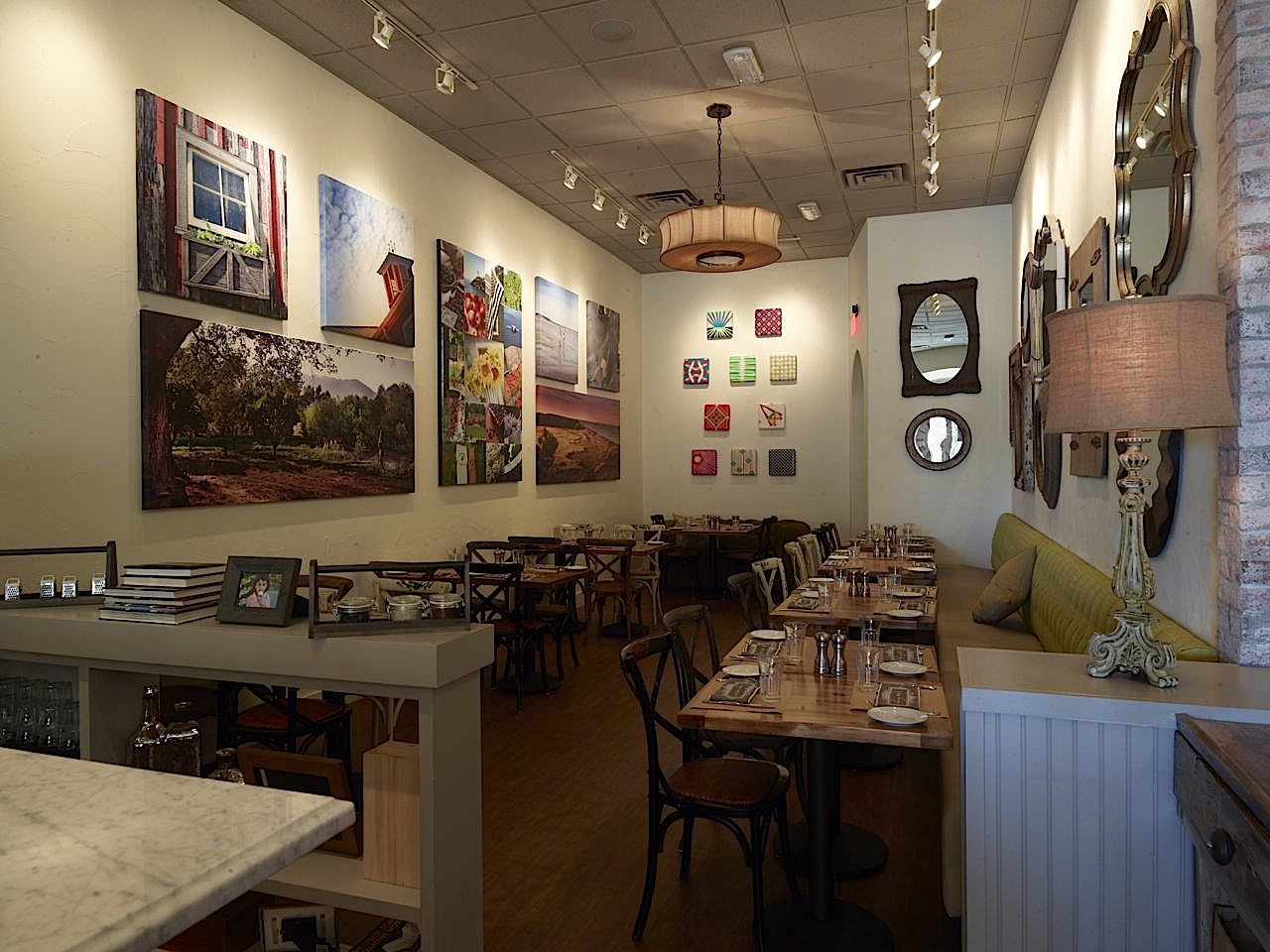 and the same dullness
permeates some of the cooking. It almost seems like
Canteenwalla (a chef with major chops) has decided
to dial back the seasonings on everything for fear
of offending someone. I'd wager even his Nana--
after whom the excellent (if somewhat mild) chicken
curry is named -- would implore her grandson to turn
up the heat. As
for the vaunted Biloxi Buttermilk Fried Chicken, it
operates under the same handicap. In this
back-to-basics time, things like burgers and fried
chicken need to be either over-the-top or
life-changing to be considered anything but an
also-ran. This one is merely good, and therefore
suffers for it.
and the same dullness
permeates some of the cooking. It almost seems like
Canteenwalla (a chef with major chops) has decided
to dial back the seasonings on everything for fear
of offending someone. I'd wager even his Nana--
after whom the excellent (if somewhat mild) chicken
curry is named -- would implore her grandson to turn
up the heat. As
for the vaunted Biloxi Buttermilk Fried Chicken, it
operates under the same handicap. In this
back-to-basics time, things like burgers and fried
chicken need to be either over-the-top or
life-changing to be considered anything but an
also-ran. This one is merely good, and therefore
suffers for it.
In a similar vein, the Farmer's Toast(s), both
heaped with fresh veggies and cheese but are so
bland and boring you'll forget you ordered them even
before the check arrives. In the chef's defense, he
deserves kudos for at least trying to jazz up
vegetarian food, à la ABC Kitchen in NYC, and
the healthful items on this menu are as ambitious as
any in town.
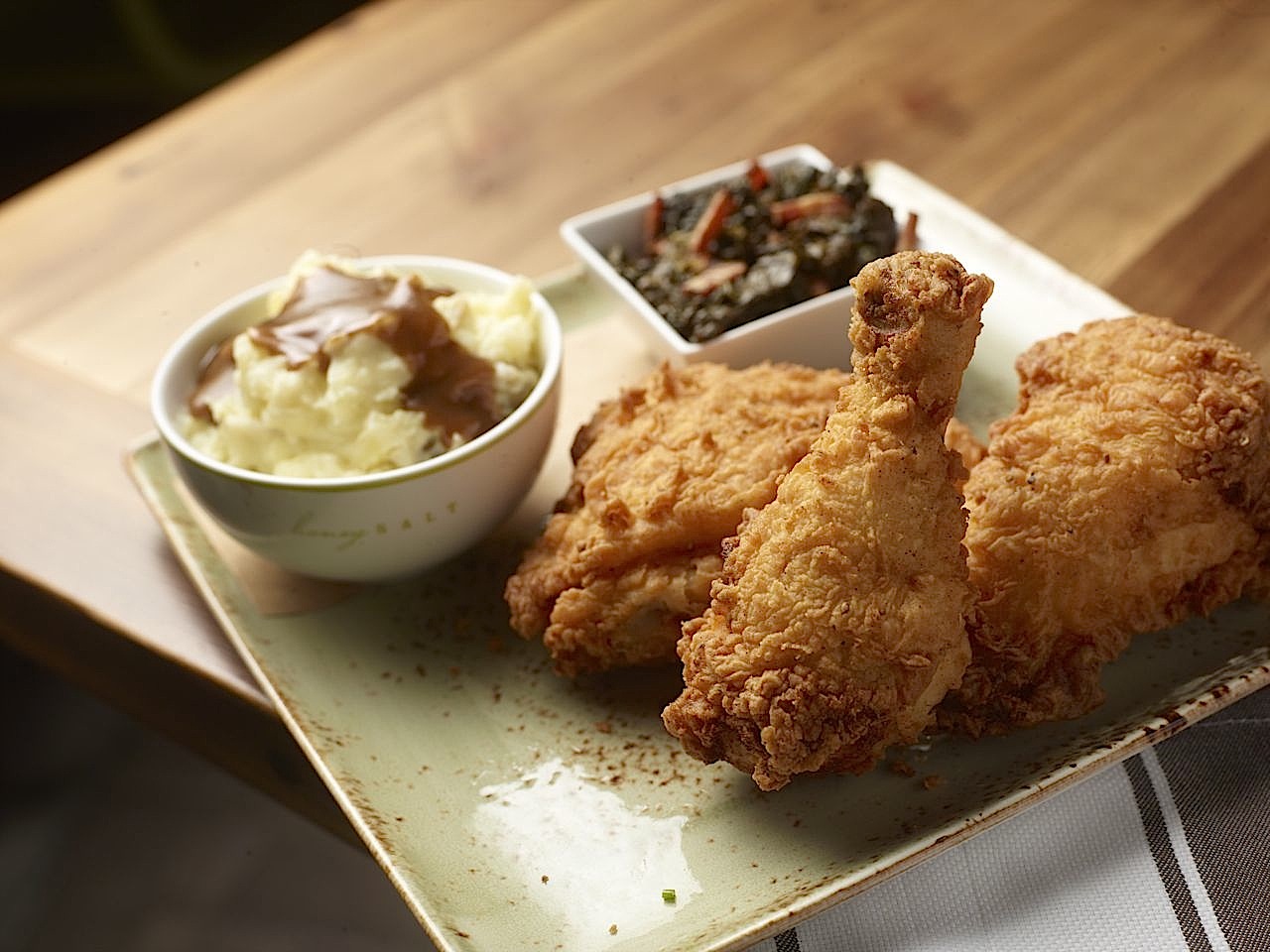 A few good beers are on hand, the wine list
is small and reasonably-priced, and of
course, there's the ubiquitous "house-made,”
“hand-crafted,” “artisanal,” blah blah blah cocktail
list that makes one yearn for a well-made Harvey
Wallbanger.
A few good beers are on hand, the wine list
is small and reasonably-priced, and of
course, there's the ubiquitous "house-made,”
“hand-crafted,” “artisanal,” blah blah blah cocktail
list that makes one yearn for a well-made Harvey
Wallbanger.
Honey Salt isn't just a restaurant; it's a
"concept." Which means it is a template for what the
investors hope will be a chain or franchise down the
road. For this reason, everything on the menu is
geared towards pleasing everybody. That's why all
the buzz words are there -- "comfort foods!" "grain
power!" "farm-to-table!" and why the swells
and Summerlin's ladies-who-lunch love it just fine.
But as Moliére observed, "The friend of all
mankind is no friend of mine," and I'd be a lot
friendlier towards Honey Salt if Kim and Elizabeth
let 'er rip and tried to make a statement with their
food instead of trying to avoid hurting anyone's
feelings, or offending anyone's palate.
Honey
Salt is open for lunch and dinner, seven days a
week. Lunch entrees run from $9-$22 with dinner
prices ranging from $8-$15 for starters and
$18-$32 for main courses.
POPPY DEN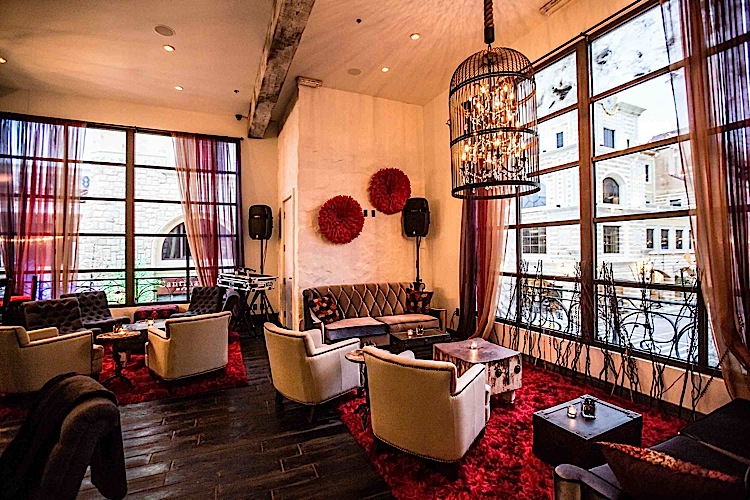
Inside
Tivoli Village
440
South Rampart Boulevard
702-802-2480
Poppy Den is also on a quest
for a successful brand (a New York offshoot is in
the works) -- but chefs know where the spice cabinet
is.
Top Chef contestant Angelo Sosa
proudly struts his stuff as a Jean-Georges
Vongerichten acolyte and demonstrates his
fusion training with all sorts of familiar goods
tweaked with the spicing and techniques of Southeast
Asia. The best damn soup in town might be his tomato
bisque with curry foam, and it's hard to fault his
ultra-crispy "General's Chicken Wing" -- lacquered
with sweet, viscous soy sauce -- and finishing on
the palate with the subtle-yet-strong heat of this
Korean bar food mainstay.
Less successful among the small plates are the 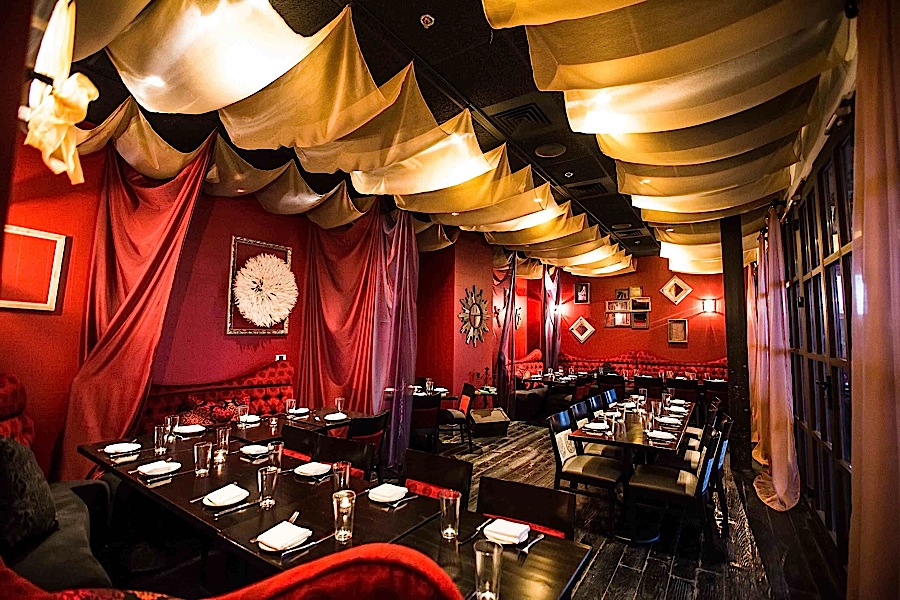 seared pork dumplings,
which resemble frozen, fried egg rolls and not the
potstickers they're described as. And Aunt Carmen's
Fish Fritters (what's with all this homey menu
nomenclature?) that no one will ever mistake for a
Thai fish cake, these being tiny balls of deep fried
mush, i.e.,
all filler and little fish. Sosa's meatballs are
miniscule but his tuna deviled eggs are are a nice
way to jazz up the overplayed "tartare," in this
case mixing raw fish chunks with a separate salad of
hard-cooked whites tossed in a "deviled" dressing.
seared pork dumplings,
which resemble frozen, fried egg rolls and not the
potstickers they're described as. And Aunt Carmen's
Fish Fritters (what's with all this homey menu
nomenclature?) that no one will ever mistake for a
Thai fish cake, these being tiny balls of deep fried
mush, i.e.,
all filler and little fish. Sosa's meatballs are
miniscule but his tuna deviled eggs are are a nice
way to jazz up the overplayed "tartare," in this
case mixing raw fish chunks with a separate salad of
hard-cooked whites tossed in a "deviled" dressing.
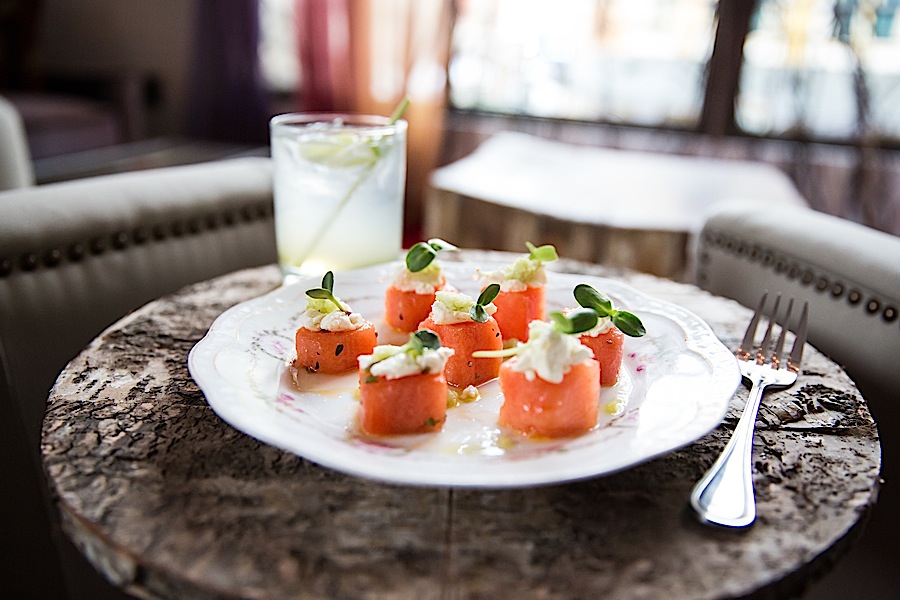 His sweet and
savory "fried rice" quinoa with dried pineapple is
also a winner, as is his roast duck with bok choy,
but the ballyhooed "poppy fries with kim cheese
sauce" are so tepid in taste and texture they could
pass muster at an old folks home serving pre-chewed
food.
His sweet and
savory "fried rice" quinoa with dried pineapple is
also a winner, as is his roast duck with bok choy,
but the ballyhooed "poppy fries with kim cheese
sauce" are so tepid in taste and texture they could
pass muster at an old folks home serving pre-chewed
food.
Things improve immeasurably once you get to Sosa’s
meat and fish offerings. Pork belly may be the
cupcake of the savory world, but he crisps his to a
fare thee well, and his miso salmon is a worthy
homage to Nobu’s iconic dish.
Desserts
tend to be de-constructed riffs on classics, like his
strawberry shortcake with housemade ice cream in a
clear pool of strawberry syrup. Like the times they
are served in, are light, simple, and unchallenging.
But this is but picayune complaint from a
persnickety critic. Both Poppy Den and Honey Salt
are probably perfect for this era and the clientele
they wish to serve. Both are products of "name"
chefs who have decided to bring their talents to the
'burbs rather than fight the corporate bureaucracies
of the Strip. (In a similar vein, Bradley Ogden will
be opening his own casual joint next door to Poppy
Den in the near future.)
Many, like yours truly, long for a time when
restaurants were started by owners and/or chefs
simply looking for a place to cook and serve their
food. A time when sugarplum thoughts of “brand
expansion” and “franchised success” weren't the
watchwords of this industry. But this is the world
we live in, and corporate calculations or not, both
Honey Salt and Poppy Den are miles better than
anything Las Vegas neighborhoods have seen before.
Poppy
Den is open for lunch and dinner, seven days a
week, with small plates running $7-$14, and large
plates ranging between $14-$23.
❖❖❖
by John Mariani
photos by Melissa Hom
SIRIO ristorante

Pierre Hotel
795 Fifth Avenue (at 60th Street)
212-940-8195
www.siriony.com
The Maccioni family--father Sirio, sons
Mario, Marco, and Mauro--have for four decades
given New York and, now, other parts of the
world high standards fro French and Italian
cuisine in various forms.
The flagship is Le Cirque,
itself in its third incarnation, on Manhattan's
East Side, with the Italian restaurant Circo on
the West Side overseen by Sirio's wife,
Egidiana. There are also restaurants in
Las Vegas, New Delhi, and the Dominican
Republic, even 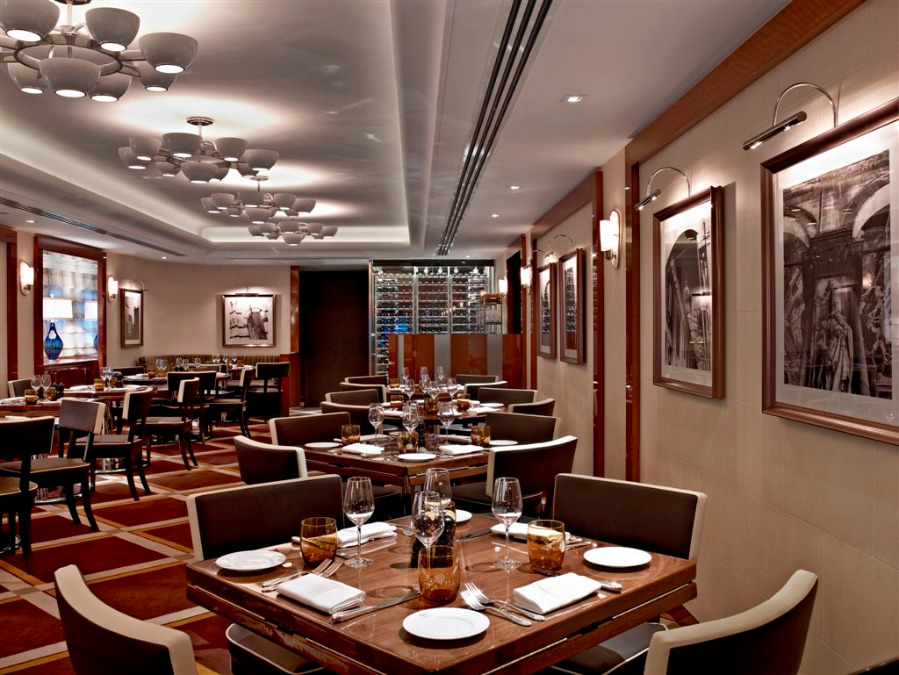 one on a
cruise ship, and while there are not enough
Maccionis to go around, various members do pay
frequent visits to their holdings. The
newest addition to their mini-empire is Sirio
Ristorante (they also run a place of the same
name in Vegas), located in the Pierre
Hotel. Marco Maccioni describes the new
spot on Fifth Avenue as a "neighborhood ristorante
distinguished from Le Cirque, which serves haute
cuisine to a global audience and Circo, which is
closer to a Tuscan trattoria."
one on a
cruise ship, and while there are not enough
Maccionis to go around, various members do pay
frequent visits to their holdings. The
newest addition to their mini-empire is Sirio
Ristorante (they also run a place of the same
name in Vegas), located in the Pierre
Hotel. Marco Maccioni describes the new
spot on Fifth Avenue as a "neighborhood ristorante
distinguished from Le Cirque, which serves haute
cuisine to a global audience and Circo, which is
closer to a Tuscan trattoria."
Walking into Sirio, you'll
see what he means: where Le Cirque is all grand
décor and Circo is indeed more like
a circus tent, Sirio is a sleek, long
sophisticated dining room with a popular,
polished bar up front; there are no tablecloths;
the floors have a large inlaid cross-stitch
pattern; there are Italian black and white
photos on the walls, while wines sit behind
glass to the rear. The tables all have flaps
that can increase the space in case friends show
up unexpectedly. And you can tell from the
clientele that they are indeed from the upper
east side neighborhood in dress (casual chic)
and demeanor (restrained exuberance), most of
them on a first-name basis with the Maccionis.
There is also a sprinkling of hotel guests (the
Maccionis do breakfast and lunch here, but no
banquets), and, as the word gets around about
Chef Filippo Gozzoli (right), people who love both
classic and modern Italian food are beginning to
discover Sirio Ristorante.
Born and raised in Cremona, Italy, Gozzoli has
an extraordinary résumé that
includes Rome's La Terrazza dell’Eden and 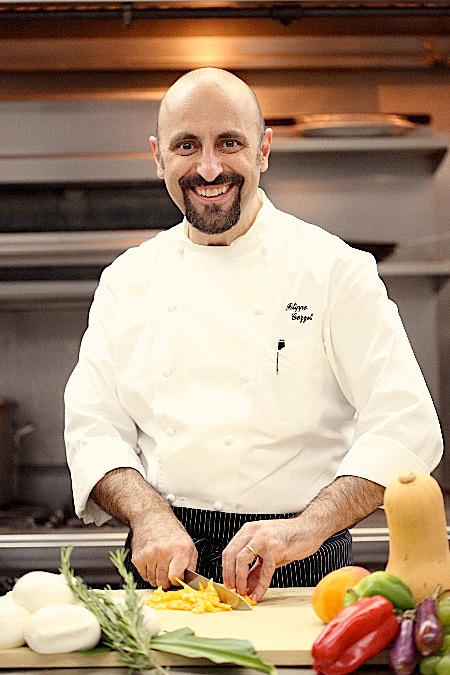 the
Hotel de Russie, The Bauer Hotel in Venice, the
Park Hyatt Milan, and other restaurants of
renown. So he comes to Le Cirque with a
reputation for high excellence in classic
cuisine, and for the first few weeks, Gozzoli
was treading carefully with the Maccionis'
clientele, turning out textbook examples of
dishes like eggplant alla parmigiana in puff
pastry, veal cutlet alla milanese (perhaps the
finest in NYC), and bistecca alla fiorentina, all
of which I thoroughly enjoyed upon my first
visit.
the
Hotel de Russie, The Bauer Hotel in Venice, the
Park Hyatt Milan, and other restaurants of
renown. So he comes to Le Cirque with a
reputation for high excellence in classic
cuisine, and for the first few weeks, Gozzoli
was treading carefully with the Maccionis'
clientele, turning out textbook examples of
dishes like eggplant alla parmigiana in puff
pastry, veal cutlet alla milanese (perhaps the
finest in NYC), and bistecca alla fiorentina, all
of which I thoroughly enjoyed upon my first
visit.
I had
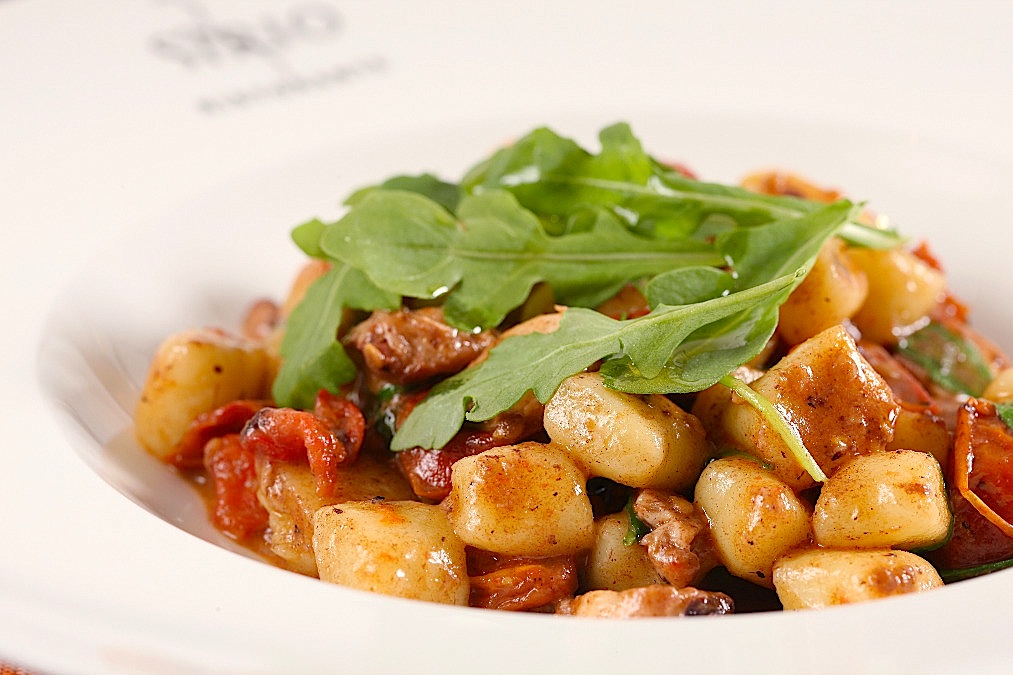 hoped that night that
Gozzoli might better show his individual
strengths in more personalized dishes, so a
visit this past week made me very happy indeed
to see how things have already evolved.
hoped that night that
Gozzoli might better show his individual
strengths in more personalized dishes, so a
visit this past week made me very happy indeed
to see how things have already evolved.
You may well begin with an
assortment of salumi
that includes Prosciutto
di Parma, coppa, salame Toscano, guanciale,
and
mortadella, or take flagrant advantage
of the caviar and crudo bars. But the antipasti
section is where Gozzoli shines. His papa al pomodoro--a
very homey dish of Tuscany made from tomatoes,
bread, garlic, olive oil and Parmigiano--was a
little unorthodox by having the bread so
thoroughly incorporated, but the dish was as
divine as it was earthy. Vitello tonnato was
a version with small rounds of tender veal
sauced with a tuna mayonnaise.
The pastas are triumphs here,
first and foremost his gnocchetti of potato (above),
light as puffed-up pillows, with roasted
octopus, cherry tomatoes, and arugula. Spaghetti alla
carbonara showed that the chef learned
his lessons well in Rome, where this dish
originated; the spaghetti was perfectly al dente,
the nubbins of guanciale, egg yolk, and
Parmigiano blended in with creamy finesse.  Housemade papparadelle
noodles came with a lusty ragù
of veal, beef, and pork tossed with chopped
basil--it smelled as wonderful as it tasted. I
was so happy to see risotto mantecato on the menu,
one of the most luscious rice dishes in the
repertoire, made with fava beans, peas, and a
sweet balsamic reduction.
Housemade papparadelle
noodles came with a lusty ragù
of veal, beef, and pork tossed with chopped
basil--it smelled as wonderful as it tasted. I
was so happy to see risotto mantecato on the menu,
one of the most luscious rice dishes in the
repertoire, made with fava beans, peas, and a
sweet balsamic reduction.
The main courses we
enjoyed included that crisp, buttery veal
cutlet, unadorned by salad on top. Roasted
magret of duck was silky, with spring onions,
asparagus of real flavor, and a Sangiovese wine
sauce, while a grilled branzino with potatoes and
artichokes was masterfully rendered. The
only disappointment was a boneless flounder in
white wine because the fish itself had a strong
taste and aroma.
The desserts, with which maître d' Massimo
Schiavon poured a Moscato Rosa 2010 by
Piedmont's Franz Haas, have all the sumptuous
spirit of what precedes them--a coffee semifreddo
with fudge and terrific mascarpone
sorbetto; a crisp apple tart with
grappa caramel and vanilla gelato; and
a chocolate mousse with olive oil gelato and
lemon honey gel (right).
Some of these dishes you
might find at Le Cirque or Circo. But at
Sirio everything fits seamlessly into a pattern
that has been clearly set by Gozzoli.
Experience and precision show in every dish, and
others chefs should pay attention to Gozzoli's
talent for hiding the art by being so
artful. I look forward to more innovation
at Sirio, because things are starting to get
very interesting here.
Sirio
Ristorante is open daily for breakfast, lunch,
and dinner; Appetizers $14-$36, pastas (full
portions) $24-$29, main courses $28-$36.
❖❖❖
St.-Julien Deserves the Respect of Its Siblings
by Brian Freedman
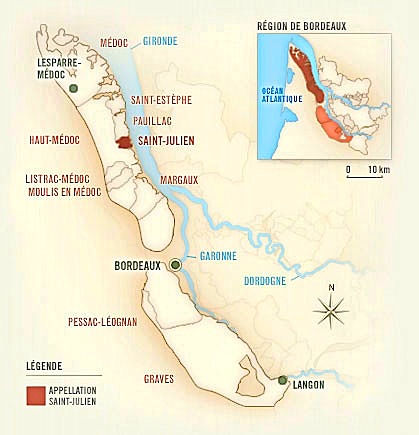 St.-Julien
has always reminded me of a particularly talented
middle child, overshadowed at first glance by its
siblings, yet easily as accomplished in reality.
Pauillac, its more glamorous neighbor to the north, is
home to three of the most lusted over wines on the
planet--Latour, Lafite, and Mouton-Rothschild. And to
the south, the appellation of Margaux, with its own
eponymous First Growth and totemic château, is
recognized the world over.
St.-Julien
has always reminded me of a particularly talented
middle child, overshadowed at first glance by its
siblings, yet easily as accomplished in reality.
Pauillac, its more glamorous neighbor to the north, is
home to three of the most lusted over wines on the
planet--Latour, Lafite, and Mouton-Rothschild. And to
the south, the appellation of Margaux, with its own
eponymous First Growth and totemic château, is
recognized the world over.
For all of that, however, and despite its own lack of
First Growths, St.-Julien has, over the years, earned
droves of dedicated and passionate adherents, myself
among them.
And
no wonder: The wines of St.-Julien, considered as a
whole, tend to express the sort of elegance, finesse,
and length that Bordeaux lovers look for, according to
respected wine writer Marc Golodetz. This past
January, he was the member sponsor of a remarkable
Wine Media Guild tasting and lunch featuring three of
the appellation’s top producers: Châteaux
Léoville-Barton, Langoa-Barton, and
Beychevelle, as well as their respective proprietors,
Lilian Barton Sartorius and Phillipe Blanc.
Tastings like this one offer the unique opportunity to
not only begin to understand what sets each individual
producer apart from its neighbors, but also to see the
overarching stylistic and expressive quirks that
differentiate one appellation from another within the
Bordeaux region as a whole. As expected, these three
excellent châteaux embodied everything that Mr.
Golodetz asserted should be expressed in St.-Julien,
and that, in the real world of retail shelves and
restaurant wine lists, make them so appealing to such
a broad and passionate cross-section of the market.
Château
Léoville-Barton
In a world where Bordeaux prices are frequently the
cause of keening and lamentation among wine lovers,
Léoville-Barton has historically stood as a
beacon of hope, proof that great, age-worthy wine can
be produced here and still remain relatively
affordable, at least given the stratospheric price
context for Bordeaux these days. 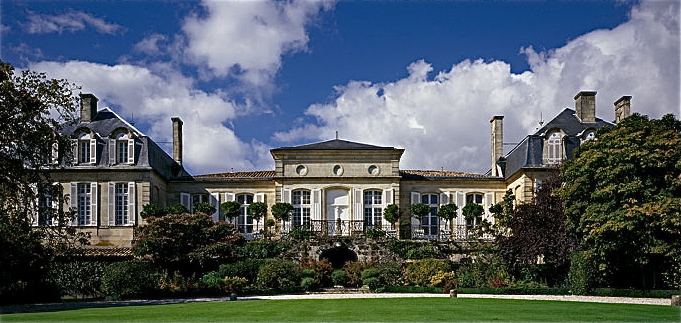
Even with a great vintage like 2005, for example,
Léoville-Barton can still be purchased for well
under $150 a bottle. The same goes for the 2009.
Compare that to Lafite 2005 at more than $1,000, and
Margaux for around the same. Even fellow Second
Growths like Cos d’Estournel (St.-Estèphe) and
Ducru-Beaucaillou (St.-Julien) are nearly double
Léoville-Barton’s general price tag in those
vintages. And while of course First Growths serve a
different purpose for many people than their
counterparts further down the classification
ladder--even among the so-called Super Seconds--the
point is that, from the perspective of pure enjoyment,
Léoville-Barton regularly ranks among the top
in the region, and all for a price that remains
attainable for most people.
The 2011, as expected, is still a baby, will gobs of
cranberry, blackberry, spiced plum, and a vanilla note
from oak that still needs time to be absorbed. There’s
plenty of potential here, but I’d let it rest in the
cellar until 2016 or so. The 2008, on the other hand,
was more linear, with pomegranate, eucalyptus, and
mineral, and a tannic structure to last through 2022+.
More perfumed than that was the 2007, whose cherry,
sandalwood, and pipe tobacco aromas led to flavors of
menthol, cherry skin, and mineral. Our last
21st-century bottling of Leoville Barton was the 2004,
a wine I have loved since it was released. At this
stage of its evolution, it’s every bit as marvelous as
it’s always been despite the vintage’s lack of
perceived prestige, with a nose perfectly mingling
currants, spice, and scorched earth, and a
velvet-textured palate, still quite grippy, speaking
of cherry pipe tobacco, cedar, and a transfixing sense
of spice. Drink now - 2024. Finally, the 1999 boasted
aromatically complex black cherry, licorice root,
sweet black currant, and scorched earth. It’s drinking
well now, and promises to continue to do so until
2022.
Château
Langoa-Barton
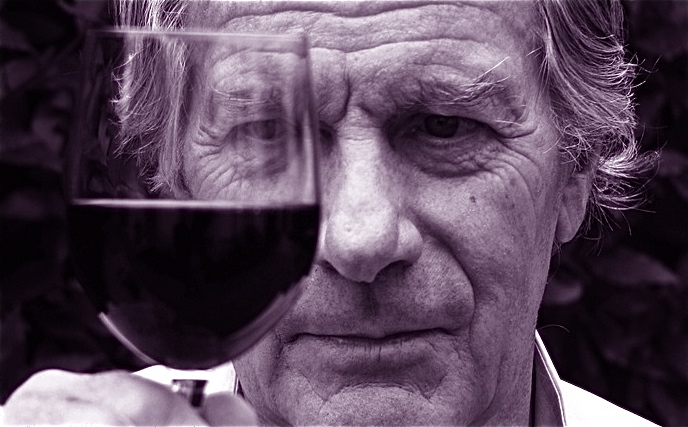 Less widely lauded than
Léoville-Barton, Third Growth Langoa-Barton is
nonetheless worthy of far more attention than it often
receives. Langoa is also owned by Anthony Barton (left), and these
wines, too, represent tremendous value. By way of
comparison, the 2005 Langoa is available for $75 or
so, and the wonderful 2009, a wine that promises to
evolve for another two decades, for around the same
price.
Less widely lauded than
Léoville-Barton, Third Growth Langoa-Barton is
nonetheless worthy of far more attention than it often
receives. Langoa is also owned by Anthony Barton (left), and these
wines, too, represent tremendous value. By way of
comparison, the 2005 Langoa is available for $75 or
so, and the wonderful 2009, a wine that promises to
evolve for another two decades, for around the same
price.
That
2009, in particular, was marvelous, with ripe, sappy
cherry, cassis, and classic aromas of pencil lead, and
a palate defined by impeccably balanced tannins and
acid, nuts, cedar, pencil lead again, and cherry.
Drink 2018 - 2033. The 2006 showed well but wasn’t
nearly as impressive, with darker notes of blueberry,
fig, and balsamic on the nose, though the palate could
have used more a center. 2005, on the other hand, was
an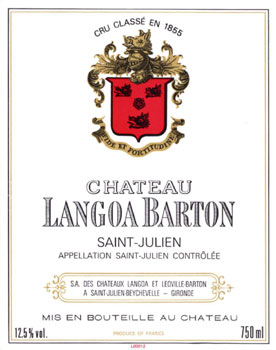 unabashed winner, with evolved aromas
of leather and grilled cherry and an exotic palate
singing with Indian spice, red currant, minerals, and
a savory finish. Drink 2017 - 2030. Langoa’s 2003
effort--and it’s a vintage that I’ve never been a
great fan of, across the spectrum in Bordeaux--seemed
typical for that notably hot year, with roasted aromas
of cherry, dried cranberries, scorched earth, and
charred meat and flavors of fig paste, grilled sage,
and a dark, rich, savory finish. Fans of the style
will like this a lot. The 2000 also expertly expressed
the character of its vintage: It’s a perfumed wine,
with blueberry, kirsch, mineral and clay notes joined
by black raspberry, fennel seed, tobacco, and cedar.
Still remarkably youthful, it promises to continue to
impress for another 15 or more years.
unabashed winner, with evolved aromas
of leather and grilled cherry and an exotic palate
singing with Indian spice, red currant, minerals, and
a savory finish. Drink 2017 - 2030. Langoa’s 2003
effort--and it’s a vintage that I’ve never been a
great fan of, across the spectrum in Bordeaux--seemed
typical for that notably hot year, with roasted aromas
of cherry, dried cranberries, scorched earth, and
charred meat and flavors of fig paste, grilled sage,
and a dark, rich, savory finish. Fans of the style
will like this a lot. The 2000 also expertly expressed
the character of its vintage: It’s a perfumed wine,
with blueberry, kirsch, mineral and clay notes joined
by black raspberry, fennel seed, tobacco, and cedar.
Still remarkably youthful, it promises to continue to
impress for another 15 or more years.
Château
Beychevelle
Located further south in St.-Julien, this Fourth
Growth out-performs that ranking year after year. Its
showing at this particular tasting was no exception: A
selection of wines, ranging from 2010 all the way back
to 1959, was exquisite, an in situ
argument for not always allowing the relative prestige
of a chateau’s classification to serve as a yard stick
by which it should be judged.
From
a pricing standpoint, Beychevelle (below) also
represents solid value: The 2005 is available anywhere
from just under $100 to around $175, depending on
where you purchase it, and the 2009, in general, a bit
less. Not inexpensive, of course, but compared to some
of the prices that so many Bordeaux command, it is a
very good relative bargain.
Of
the three châteaux at this tasting, the word
“perfumed” appears in my notes more for the wines of
Beychevelle than for either of the Bartons.
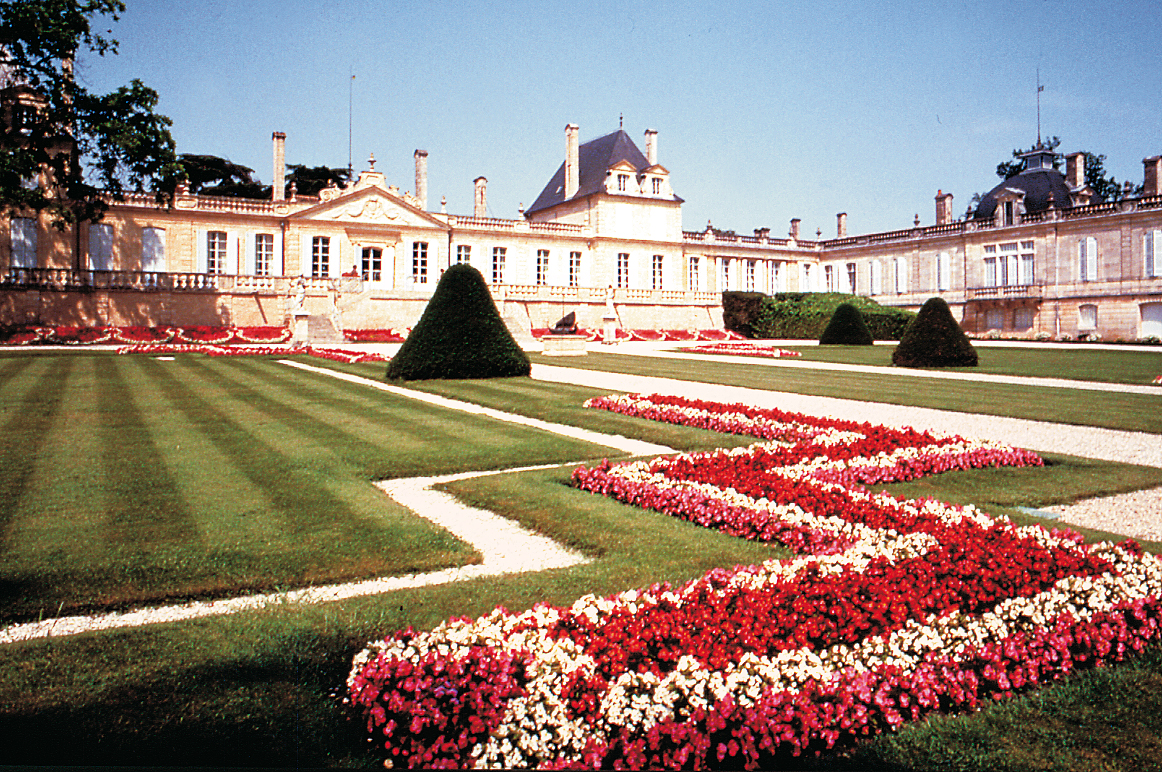 The 2010, for
example, is showing beautifully even this early in its
evolution, with beef carpaccio, perfumed cherry,
cassis, and cafe mocha. It’s readily available for
under $100, and, for a bottling that will continue to
improve for another two decades, represents a solid
value. The ripe 2009 showed fig paste, pomegranate
syrup, cherry, dark vanilla, charred orange peel, and
a hint of sage: It’s beguiling in its complexity, and
should continue to be so until the late-2020’s. The
2008, as expected, was less of a blockbuster than the
first two. And while its huckleberry, cherry, and star
anise notes were impressive, this vintage will not
likely last as long as some others. 2005, however, was
an unmitigated winner, an exotic wine singing with
Indian spice, eucalyptus, sandalwood, red currant, and
fenugreek. In my notes from the tasting, I noted that
it “reminds me of a beautiful woman - elegant and
sweet and transfixing.” Hyperbole, perhaps, and
terrible writing, but it’s a seriously accomplished
wine nonetheless.
The 2010, for
example, is showing beautifully even this early in its
evolution, with beef carpaccio, perfumed cherry,
cassis, and cafe mocha. It’s readily available for
under $100, and, for a bottling that will continue to
improve for another two decades, represents a solid
value. The ripe 2009 showed fig paste, pomegranate
syrup, cherry, dark vanilla, charred orange peel, and
a hint of sage: It’s beguiling in its complexity, and
should continue to be so until the late-2020’s. The
2008, as expected, was less of a blockbuster than the
first two. And while its huckleberry, cherry, and star
anise notes were impressive, this vintage will not
likely last as long as some others. 2005, however, was
an unmitigated winner, an exotic wine singing with
Indian spice, eucalyptus, sandalwood, red currant, and
fenugreek. In my notes from the tasting, I noted that
it “reminds me of a beautiful woman - elegant and
sweet and transfixing.” Hyperbole, perhaps, and
terrible writing, but it’s a seriously accomplished
wine nonetheless.
From there it was on to the 2003,
which was far fresher and more lively than the vintage
typically shows. With the Beychevelle, even 10 years
after the vintage, this wine was remarkably youthful
and vigorous, with sage, bell peppers, red berry
fruit, light cigar tobacco, and pencil lead. If only
all 03’s were this lively.
More universally admired is the
2000 vintage in Bordeaux, a legendary year that, here,
resulted in a wine of perfumed graphite, currants,
black licorice, menthol, blueberry, and cherry. It’s
wonderful now, and will continue to be so until 2030.
The 1999 started off unexpectedly, with aromas of
paprika and beef carpaccio that turned to appealing
flavors of charred herbs, mint, and high-toned cherry.
The 1996 is starting to hit its peak: Eucalyptus,
cranberry, pomegranate, wild strawberry, truffle,
leather, and perfumed drying cherry are hard to resist
right now. I’d drink it soon, but you can certainly
hold onto it for another eight or nine years if that’
the style you prefer. Jumping back 10 years, the 1986,
orange-toned at the edges, was mature and gorgeous,
humming a tune of fenugreek, red currants, fennel,
flowers, and meat, all of it carried on a texture both
silky and still well-structured.
Finally, the 1959 was, in hind-sight, the perfect way
to end the afternoon: Fresh with mint, vivacious with
cranberry, serious with leather, this was a fully
evolved, remarkable testament to the complexity and
potential longevity of the wines of St.-Julien, a part
of Bordeaux that is as deliciously appealing now as it
ever has been, and that provides some of the best
proverbial bang for the buck in a region that too
often is solely associated with its most expensive
wines. This tasting was delicious proof that there’s
something in Bordeaux for everyone, no matter how much
you want to spend, no mater what style you tend to
gravitate toward. St.-Julien is a very good place to
start.

MORE EVIDENCE OF BELGIAN DECADENCE!!
The Belgian post office has released
chocolate-flavored stamps, with essence of cacao
oil in the glue on the back and in the ink. A set of five stamps sell for
€6.2.
WELL, THERE GO THOSE
CHEAP DINNER DATES !
Researchers at Pennsylvania State University in
the U.S. claim that
women concerned about their diet and image
experience a worsening
of their mood after eating something
unhealthy.
Any of John Mariani's
books below may be ordered from amazon.com.
 |
My latest book, which just won the prize for best book from International Gourmand, written with Jim Heimann and Steven Heller, Menu Design in America, 1850-1985 (Taschen Books), has just appeared, with nearly 1,000 beautiful, historic, hilarious, sometimes shocking menus dating back to before the Civil War and going through the Gilded Age, the Jazz Age, the Depression, the nightclub era of the 1930s and 1940s, the Space Age era, and the age when menus were a form of advertising in innovative explosions of color and modern design. The book is a chronicle of changing tastes and mores and says as much about America as about its food and drink.
“Luxuriating vicariously in the pleasures of this book. . . you can’t help but become hungry. . .for the food of course, but also for something more: the bygone days of our country’s splendidly rich and complex past. Epicureans of both good food and artful design will do well to make it their coffee table’s main course.”—Chip Kidd, Wall Street Journal.
“[The menus] reflect the amazing craftsmanship that many restaurants applied to their bills of fare, and suggest that today’s restaurateurs could learn a lot from their predecessors.”—Rebecca Marx, The Village Voice. |
"Eating Italian will never be the same after reading John Mariani's entertaining and savory gastronomical history of the cuisine of Italy and how it won over appetites worldwide. . . . This book is such a tasteful narrative that it will literally make you hungry for Italian food and arouse your appetite for gastronomical history."--Don Oldenburg, USA Today. "Italian
restaurants--some good, some glitzy--far
outnumber their French rivals. Many of
these establishments are zestfully described
in How Italian Food Conquered the World, an
entertaining and fact-filled chronicle by
food-and-wine correspondent John F.
Mariani."--Aram Bakshian Jr., Wall Street
Journal.
"Equal parts
history, sociology, gastronomy, and just
plain fun, How Italian Food Conquered the
World tells the captivating and delicious
story of the (let's face it) everybody's
favorite cuisine with clarity, verve and
more than one surprise."--Colman Andrews,
editorial director of The Daily
Meal.com. "A fantastic and fascinating
read, covering everything from the influence
of Venice's spice trade to the impact of
Italian immigrants in America and the
evolution of alta cucina. This book will
serve as a terrific resource to anyone
interested in the real story of Italian
food."--Mary Ann Esposito, host of PBS-TV's
Ciao
Italia. "John Mariani has written the
definitive history of how Italians won their
way into our hearts, minds, and
stomachs. It's a story of pleasure over
pomp and taste over technique."--Danny Meyer,
owner of NYC restaurants Union Square Cafe,
Gotham Bar & Grill, The Modern, and
Maialino.
|
 |
 |
 |
 |
 |
 |
 |
 |
 Everett Potter's Travel Report:
Everett Potter's Travel Report: 
 Eating Las Vegas
is the new on-line site for Virtual Gourmet
contributor John A. Curtas., who since 1995
has been commenting on the Las Vegas food
scene and reviewing restaurants for Nevada
Public Radio. He is also the
restaurant critic for KLAS TV, Channel 8 in
Las Vegas, and his past reviews can be
accessed at KNPR.org.
Click on the logo below to go directly to
his site.
Eating Las Vegas
is the new on-line site for Virtual Gourmet
contributor John A. Curtas., who since 1995
has been commenting on the Las Vegas food
scene and reviewing restaurants for Nevada
Public Radio. He is also the
restaurant critic for KLAS TV, Channel 8 in
Las Vegas, and his past reviews can be
accessed at KNPR.org.
Click on the logo below to go directly to
his site.

Tennis Resorts Online: A Critical Guide to the World's Best Tennis Resorts and Tennis Camps, published by ROGER COX, who has spent more than two decades writing about tennis travel, including a 17-year stretch for Tennis magazine. He has also written for Arthur Frommer's Budget Travel, New York Magazine, Travel & Leisure, Esquire, Money, USTA Magazine, Men's Journal, and The Robb Report. He has authored two books-The World's Best Tennis Vacations (Stephen Greene Press/Viking Penguin, 1990) and The Best Places to Stay in the Rockies (Houghton Mifflin, 1992 & 1994), and the Melbourne (Australia) chapter to the Wall Street Journal Business Guide to Cities of the Pacific Rim (Fodor's Travel Guides, 1991).


MARIANI'S VIRTUAL GOURMET
NEWSLETTER is published weekly. Editor/Publisher: John
Mariani.
Contributing Writers: Christopher Mariani, Robert Mariani,
John A. Curtas, Edward Brivio, Mort Hochstein,
Suzanne Wright, and Brian Freedman. Contributing
Photographers: Galina Stepanoff-Dargery,
Bobby Pirillo. Technical Advisor: Gerry McLoughlin.
© copyright John Mariani 2013
